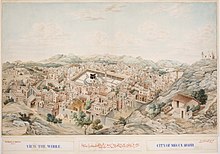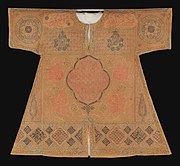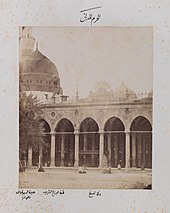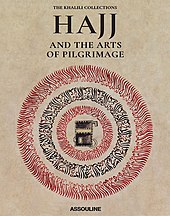
Mecca is the capital of Mecca Province in the Hejaz region of western Saudi Arabia and the holiest city in Islam. It is 70 km (43 mi) inland from Jeddah on the Red Sea, in a narrow valley 277 m (909 ft) above sea level. Its last recorded population was 2,385,509 in 2022. Its metropolitan population in 2022 is 2.4 million, making it the third-most populated city in Saudi Arabia after Riyadh and Jeddah. Around 44.5% of the population are Saudi citizens and around 55.5% are foreigners from other Muslim countries. Pilgrims more than triple the population number every year during the Ḥajj pilgrimage, observed in the twelfth Hijri month of Dhūl-Ḥijjah. With over 10.8 million international visitors in 2023, Mecca was one of the 10 most visited cities in the world.

The Black Stone is a rock set into the eastern corner of the Kaaba, the ancient building in the center of the Grand Mosque in Mecca, Saudi Arabia. It is revered by Muslims as an Islamic relic which, according to Muslim tradition, dates back to the time of Adam and Eve.

Kiswa is the cloth that covers the Kaaba in Mecca, Saudi Arabia. It is draped annually on the 9th day of the month of Dhu al-Hijjah, the day pilgrims leave for the plains of Mount Arafat during the Hajj. A procession traditionally accompanies the kiswa to Mecca, a tradition dating back to the 12th century. The term kiswa has multiple translations, with common ones being 'robe' or 'garment'. Due to the iconic designs and the quality of materials used in creating the kiswa, it is considered one of the most sacred objects in Islamic art, ritual, and worship.

The holiest sites in Islam are predominantly located in the Arabian Peninsula and the Levant. While the significance of most places typically varies depending on the Islamic sect, there is a consensus across all mainstream branches of the religion that affirms three cities as having the highest degree of holiness, in descending order: Mecca, Medina, and Jerusalem. Mecca's Al-Masjid al-Haram, Al-Masjid an-Nabawi in Medina and Al-Masjid al-Aqsa in Jerusalem are all revered by Muslims as sites of great importance.

Dalāʼil al-khayrāt wa-shawāriq al-anwār fī dhikr al-ṣalāt ʻalá al-Nabī al-mukhtār, usually shortened to Dala'il al-Khayrat, is a famous collection of prayers for the Islamic prophet Muhammad, which was written by the Moroccan Shadhili scholar Muhammad al-Jazuli. It is popular in parts of the Islamic world amongst traditional Muslims—specifically North Africa, the Levant, Turkey, the Caucasus and South Asia—and is divided into sections for daily recitation.

The Kaaba, sometimes referred to as al-Ka'ba al-Musharrafa, is a stone building at the center of Islam's most important mosque and holiest site, the Masjid al-Haram in Mecca, Saudi Arabia. It is considered by Muslims to be the Bayt Allah and is the qibla for Muslims around the world. The current structure was built after the original building was damaged by fire during the siege of Mecca by Umayyads in 683 AD.

Hajj is an annual Islamic pilgrimage to Mecca, Saudi Arabia, the holiest city for Muslims. Hajj is a mandatory religious duty for Muslims that must be carried out at least once in their lifetime by all adult Muslims who are physically and financially capable of undertaking the journey, and of supporting their family during their absence from home.
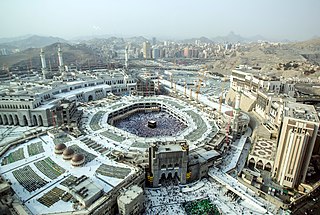
Masjid al-Haram, also known as the Sacred Mosque or the Great Mosque of Mecca, is considered to be the most significant mosque in Islam. It encloses the vicinity of the Kaaba in Mecca, in the Mecca Province of Saudi Arabia. It is among the pilgrimage sites associated with the Hajj, which every Muslim must perform at least once in their lives if able. It is also the main site for the performance of ʿUmrah, the lesser pilgrimage that can be undertaken any time of the year. The rites of both pilgrimages include circumambulating the Kaaba within the mosque. The Great Mosque includes other important significant sites, such as the Black Stone, the Zamzam Well, Maqam Ibrahim, and the hills of Safa and Marwa.

The hajj is a pilgrimage to Mecca performed by millions of Muslims every year, coming from all over the Muslim world. Its history goes back many centuries. The present pattern of the Islamic Hajj was established by Islamic prophet Muhammad, around 632 CE, who reformed the existing pilgrimage tradition of the pagan Arabs. According to Islamic tradition, the hajj dates from thousands of years earlier, from when Abraham, upon God's command, built the Kaaba. This cubic building is considered the most holy site in Islam and the rituals of the hajj include walking repeatedly around it.

A talismanic shirt is a worn textile talisman. Talismanic shirts are found throughout the Muslim world. The shirts can be grouped to four types which differ in style and the symbols used: an Ottoman, a Safavid, a Mughal and a West African one.

Embroidery was an important art in the Islamic world from the beginning of Islam until the Industrial Revolution disrupted traditional ways of life.
Muḥyi al-Dīn Lārī, died 1521 or 1526–7, was a 16th-century miniaturist and writer, best known for his Kitab Futūḥ al-Ḥaramayn, a guidebook to the Islamic holy cities of Mecca and Medina.

The Khalili Collections are eight distinct art collections assembled by Nasser D. Khalili over five decades. Together, the collections include some 35,000 works of art, and each is considered among the most important in its field.

The Anis Al-Hujjaj is a seventeenth-century literary work by Safi ibn Vali, an official of the Mughal court in what is now India. Written in Persian, it describes the Hajj undertaken by him in 1677 AD and it gives advice to pilgrims. Its illustrations depict pilgrims travelling to the holy sites and taking part in the rituals of the Hajj. They are also a visual guide to significant places and people.

A mahmal is a ceremonial passenger-less litter that was carried on a camel among caravans of pilgrims on the Hajj, the pilgrimage to Mecca which is a sacred duty in Islam. It symbolised the political power of the sultans who sent it, demonstrating their custody of Islam's holy sites. Each mahmal had an intricately embroidered textile cover, or sitr. The tradition dates back at least to the 13th century and ended in the mid-20th. There are many descriptions and photographs of mahmals from 19th century observers of the Hajj.

A sitara or sitarah is an ornamental curtain used in the sacred sites of Islam. A sitara forms part of the kiswah, the cloth covering of the Kaaba in Mecca. Another sitara adorns the Prophet's Tomb in the Al-Masjid an-Nabawi mosque in Medina. These textiles bear embroidered inscriptions of verses from the Quran and other significant texts. Sitaras have been created annually since the 16th century as part of a set of textiles sent to Mecca. The tradition is that the textiles are provided by the ruler responsible for the holy sites. In different eras, this has meant the Mamluk Sultans, the Sultans of the Ottoman Empire, and presently the rulers of Saudi Arabia. The construction of the sitaras is both an act of religious devotion and a demonstration of the wealth of the rulers who commission them.

Futuh al-Haramayn is considered the first Islamic guidebook for pilgrimage. It was written by Muhi al-Din Lari and completed in India in 1505–6. The book was dedicated to Muzaffar ibn Mahmudshah, the ruler of Gujarat. No early illustrated Indian copies are known, but later in the 16th century it was widely copied in Ottoman Turkey. The book describes the full rituals of the Hajj in order, and describes the religious sites one can visit.

Muhammad Sadiq Bey was an Ottoman Egyptian army engineer and surveyor who served as treasurer of the Hajj pilgrim caravan. As a photographer and author, he documented the holy sites of Islam at Mecca and Medina, taking the first ever photographs in what is now Saudi Arabia.
The Dar al-Kiswa al-Sharifa, abbreviated Dar al-Kiswa, was an artistic workshop in Cairo, Egypt, which operated from 1817 to 1997. For more than a century, it made sacred textiles for the Islamic holy sites in Mecca and Medina including the kiswah, the ornamental textile covering of the Kaaba which is replaced annually. The kiswah and other sacred textiles were conveyed each year across the hundreds of miles of desert from Cairo to Mecca on camels among the Hajj pilgrims. The workshop also made textiles for royal and state purposes, including military and police uniforms. At its peak at the start of the 20th century, the workshop employed over a hundred craftsmen to make textiles for the holy sites. Egypt sent the kiswah every year with few exceptions until 1962, when the kiswah sent to Mecca was returned unused. From then on, the textiles were made in a dedicated factory in Mecca. The building is now a government storage space.

Hajj: Journey to the Heart of Islam was an exhibition held at the British Museum in London from 26 January to 15 April 2012. It was the world's first major exhibition telling the story, visually and textually, of the hajj – the pilgrimage to Mecca which is one of the five pillars of Islam. Textiles, manuscripts, historical documents, photographs, and art works from many different countries and eras were displayed to illustrate the themes of travel to Mecca, hajj rituals, and the Kaaba. More than two hundred objects were included, drawn from forty public and private collections in a total of fourteen countries. The largest contributor was David Khalili's family trust, which lent many objects that would later be part of the Khalili Collection of Hajj and the Arts of Pilgrimage.

